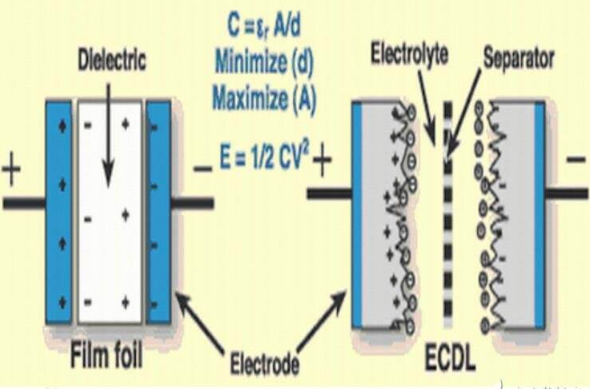Principles and characteristics of supercapacitors_Supercapacitor parameters
This article mainly introduces the principle, characteristics, and parameters of supercapacitors. Supercapacitors are a new type of energy storage device that bridges the gap between traditional capacitors and rechargeable batteries, possessing both the rapid charging and discharging characteristics of capacitors and the energy storage characteristics of batteries.
Principle of Supercapacitors
Supercapacitors are a new type of device that stores energy through the interface double layer formed between the electrode and the electrolyte. When the electrode comes into contact with the electrolyte, the Coulomb force, intermolecular force, and interatomic force cause a stable and oppositely charged double layer of the solid-liquid interface, known as the interface double layer. The double layer supercapacitor can be viewed as two non-active porous plates suspended in the electrolyte, with a voltage applied to the two plates. The potential applied to the positive electrode plate attracts negative ions in the electrolyte, while the negative electrode plate attracts positive ions, forming a double-layer capacitor on the surface of the two electrodes. Depending on the electrode material, double-layer capacitors can be divided into carbon electrode double-layer supercapacitors, metal oxide electrode supercapacitors, and organic polymer electrode supercapacitors.
Characteristics of Supercapacitors
Compared with batteries and traditional physical capacitors, the characteristics of supercapacitors mainly include:
1. High power density: up to 102-104 W/kg, far higher than the power density of batteries.
2. Long cycle life: After 500,000 to 1 million cycles of deep charging and discharging in a few seconds, the characteristics of supercapacitors change very little, with only a 10%-20% decrease in capacity and internal resistance.
3. Wide working temperature range: Since the adsorption and desorption rates of ions in supercapacitors do not change significantly at low temperatures, their capacity changes far less than that of batteries. The working temperature range of commercial supercapacitors can reach -40℃ to +80℃.
4. Maintenance-free: Supercapacitors have high charging and discharging efficiency, and can withstand overcharging and over-discharging, allowing for stable and repeated charging and discharging without the need for maintenance.
5. Green and environmentally friendly: Super capacitors do not use heavy metals and other harmful chemicals in the production process, and have a longer lifespan, making them a new type of green and environmentally friendly power source.

Parameters of Supercapacitors
1. Life: The capacity of supercapacitors decreases as the internal resistance increases. Within the specified parameter range, its effective use time can be extended, which is generally related to the fourth characteristic. The factors that affect the life of supercapacitors are active dryness, increased internal resistance, and a decrease in energy storage capacity to 63.2%, which is called the end of life.
2. Voltage: Supercapacitors have a recommended voltage and an optimal operating voltage. If the voltage used is higher than the recommended voltage, the life of the capacitor will be shortened. However, the capacitor can work continuously under excessively high voltage, and the activated carbon inside the capacitor will decompose to form gas, which is beneficial for energy storage. But it cannot exceed 1.3 times the recommended voltage, otherwise, the supercapacitor will be damaged due to excessive voltage.
3. Temperature: The normal operating temperature of supercapacitors is -40~70℃. Temperature and voltage are important factors that affect the life of supercapacitors. For every 5°C increase in temperature, the life of the capacitor will decrease by 10%. At low temperatures, increasing the working voltage of the capacitor will not increase the internal resistance of the capacitor, but will improve the efficiency of the capacitor.
4. Discharge: In pulse charging technology, the internal resistance of the capacitor is an important factor, while capacity is an important factor in low current discharge.
5. Charging: There are various ways to charge capacitors, such as constant current charging, constant voltage charging, and pulse charging. In the charging process, adding a resistor in series with the capacitor circuit will reduce the charging current and improve the life of the battery.
These are the principles, characteristics, and parameters of supercapacitors. We hope this information is helpful to you.
Recent Posts








Company
About UsContact UsTerms & ConditionsPrivacy StatementPayment,Shipping & InvoiceRefund & Return PolicyWarranty PolicyFrequently asked questionHolidays for Chinese Mid-Autumn Festival and National Day in 2023
